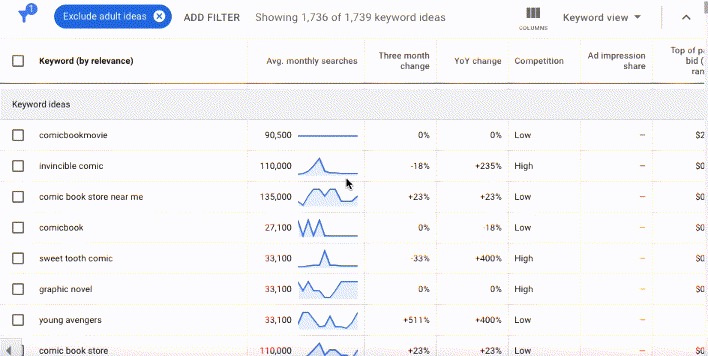This essay originally appeared in the October 10, 2019 issue with the email subject line "Your content business is not a war" and a review of content intelligence tool Buzzsumo.
I stan conversation. My digital strategy business is built from listening to others — not just to their digital signals and what they type into search bars and forums, but also anticipating their needs and next steps.
Another major part of my work is listening to my clients’ business and workplace needs and matching them with what their audiences are saying. We have a series of conversations, and those conversations turn into true collaboration.
I’ve spent the better part of the past two years trying to become a better conversationalist and an active listener. It takes practice to hear everything a client or a colleague is saying, and not just what you want to hear.
It takes effort to get out of the conversation simulacrum that content work requires: where you only hear the bits that fit into your existing narrative because getting too far afield can be a big time waster.
![Blanche from Golden Girls looks someone up and down and gives side-eye. [gif]](https://cdn.substack.com/image/fetch/w_1100,c_limit,f_auto,q_auto:good/https%3A%2F%2Fbucketeer-e05bbc84-baa3-437e-9518-adb32be77984.s3.amazonaws.com%2Fpublic%2Fimages%2Fb436e045-a9c1-47af-90ba-2bb65f65088c_310x207.gif)
Because part of listening is hearing what your conversation partners are not saying. It’s identifying what they are withholding from you because:
- Of trust
- Or time
- Or rabbit holes that are best not explored because they bring up a lot of pain
- Or perceived power imbalances
- Or they’ve heard you say things like “people are idiots. people don’t read.” (I’m looking at you, every content creator or marketer ever.)
- Or you have a legacy of misunderstanding and belittling others’ needs and thoughts, and they just want to get out of the conversation, like, now.
If you feel your content business is not reaching the goals you set, you need to make a goal to be a true, active listener. If you are frustrated because no one is buying the content you’re selling, maybe you need to focus on creating content from a place of empathy and responsiveness, because newsflash: great content is so hot right now. Empathy makes great content. (Hence: podcasts.)
Content in the next decade is going to be about conversation. Conversation is about listening, being empathetic to what you hear, being vulnerable enough to understand that meeting others’ needs requires proactive change, and pivoting to meet those needs where it makes the most business sense.
![Don Draper says, "What?" [gif]](https://cdn.substack.com/image/fetch/w_1100,c_limit,f_auto,q_auto:good/https%3A%2F%2Fbucketeer-e05bbc84-baa3-437e-9518-adb32be77984.s3.amazonaws.com%2Fpublic%2Fimages%2Fa1f832ff-c76a-42f6-95cd-3fd49ad70f29_480x264.gif)
How to listen to what your audience is not saying
- Search data search data search data. We are having conversations with search engines all the time! Google query data is still an amazing resource of human desire, professional and personal. And what shows up as the top result for any query is likely a tried-and-true display of what customers actually want to see because Google prioritizes search results based on user behavior. The unguided collection of query data makes Google results about 100x more valuable than any casually delivered user survey, which allows no call-and-response and is often hastily constructed and poorly worded.
- One-to-one digital conversations. People communicate differently via chat or text than they do in other media. Users have a perceived anonymity where your audience may tell you what you think… but if they’re actually talking to a person and not just shouting into the comments section, they may. Think of it like that terrible television show Undercover Boss, where awful people learn that the people who work for them deserve to be treated like humans: if users don’t know anything besides that you might listen and respond to them on their level but *also* that you’re a human, they’ll likely be more candid with you and provide great feedback. (Hot tip: Transform this skill into revenue with a membership/Patreon-style model.)
- In-person conversations. Any UX researcher will tell you that speaking with different audiences, with focus groups, gets to a different level of depth and empathy than others. And in person, you can evaluate faces, body language. But by all means — spend your focus group listening. Don’t talk.
- Website behavior. There are people who visit your website or content to read/listen but don’t subscribe. How do they behave? They are not idiots! They think you have value because they spend time reading your work… but maybe what you’re saying doesn’t fit into their idea of a good conversation. They may not be your “ideal audience” but I recommend considering how those outside groups add value to your conversation.
Be aware of new voices, always. Every week make a goal to read someone you haven’t read before, who maybe has a different background than you. Break out of your habit of only watching the news or only reading five of the same websites owned by the same legacy media companies. Subscribe to a few more newsletters. Read/listen to more women of color, indigenous people and people who may not use your ideal version of English grammar.
And when you’re reading new voices, do your best to hear their new ideas without immediately dismissing them as wrong or different. (This is admittedly a really hard practice for me!) Think about how their ideas and experiences have value. Everybody’s voice has value*, especially if they are actively listening and responding to others. That’s why I’m a huge fan of influencers who make a point of engaging with their audiences. It’s a good way to be!
*Except the giant baby visiting my city today. He has spoken far too much without listening for decades now.
A Nieman Labs story last week ran with the headline, “The business case for listening to your audience is still murky (but early results are promising).” The headline is a poor summary of the article, which happens too often!, but the story is news orgs using two crowdsourced reporting tools.
Nieman Labs’ article draws the unfortunate conclusion that using these tools hasn’t brought in more subscribers… yet. Those results are likely more the fault of a poor publishing strategy and lack of understanding on how digital audiences behave than the “the business case for listening to your audience.” Even the most relevant content doesn’t cause conversions on its own. (Think HBO v. Netflix: I can only afford one, but even though I’d love to binge Succession because I’m a media person, Netflix just has more content I like, it’s cheaper, and it doesn’t crash/buffer like the HBO app.)
I’d love to see the tactics used by the newsrooms that are converting subscribers compared to those that aren’t. Maybe it’s the next chapter?

In ten years listening to clients and audiences and mapping the paths to conversation, I’d argue there is absolutely a case for content businesses to listen to their audiences. Especially newsrooms and other media businesses, which have had a free pass to broadcast for so long.
But content businesses have to be proactive about making listening a conversation and not just a smile and a nod and a “here’s what I think anyway.”
Hand-picked related content







